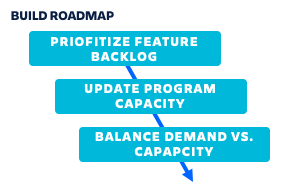Introduction

“Invest in the future because that is where you are going to spend the rest of your life.” - Habeeb Akande (Author and Historian)
As organizations evolve and strive to pivot and persevere quickly, understanding the impacts of those moves is critical to maintaining a healthy business. Roadmaps provide the ability for us to forecast where we want to go and thus give us the ability to understand how changes on our journey impact what’s next.
Decisions to make
- Stack rank the feature backlog for the next planning period (or two), prioritizing by expected business value
- Decide what capacity of the program will be available for execution of the items in the backlog and roadmap (i.e. buffers for defect repair, etc.)
- When the targeted backlog exceeds the available capacity for the next planning period, decide whether to scale back targets (i.e. push work out on the timeline)
Context
- Themes, epics, and features are created, with sizing and target delivery timeframes identified
- Team and program capacity data is available (e.g. history velocity) to help validate the the roadmap
- Fixed date milestones on epics and/or objective milestones have been created and linked to work items
Why we care
- Roadmaps are the junctions of work planned and time, and they help set expectations across the organization for when work will get done
- Grouping of items under parent objects in the roadmap view should provide the stakeholders information about the expected timeline of large chunks of work
- Realistic roadmaps give leaders the ability to flag risks up front and share that information with all relevant stakeholders
- Roadmaps give insights on the connections between the strategy level (e.g. themes) and the team level (e.g. stories) of the work planned, which is something very useful for the organization when it comes to presenting accurate data
- Flexible roadmaps with relevant milestones are inseparable from an efficient delivery lifecycle
The Atlassian view
- Portfolio managers and product teams are expected to refine the epic and feature backlog and map them with the planning period objects (e.g. program increments) in order to get a view of the work planned
- Features need to be linked to parent objects (i.e. epics) so that we can get a more consolidated view of the roadmap. We can group the features by epics, and if epics are grouped by themes then we can group the epics by themes as well in the planning view
- If the backlogs of the teams are well refined then we can get a more accurate roadmap view based on the target end iteration for the feature
- Roadmaps can be built in both an internal, planning view (iteration/sprint by program increment) and an external, stakeholder communication view (month by quarter)
- The roadmap view in Jira Align is highly customizable and in the configuration options we can also group them by objectives, programs, parents, or themes
Next step:
Jobs to be doneWas this content helpful?
Connect, share, or get additional help
Atlassian Community